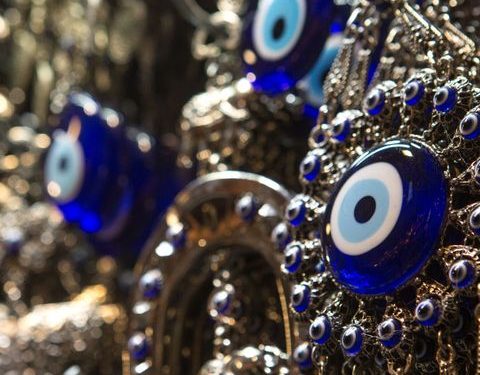Turkey has been hit by a fever of the “evil eye” talisman, which is believed to ward off ill will, which led religious authorities to issue fatwas denouncing the ornament.
“In Islam, attitudes, behavior, and beliefs attributing influence to other than Allah are strictly prohibited,” said Diyanet, Turkey’s religious authority.
“It is not permissible to wear amulets and any object around the neck, or anywhere else, to benefit from it,” the statement continued.
The ‘evil eye’ talisman is a blue glass in the shape of an eye. These accessories are used for necklaces, rings, bracelets, key chains, and various other accessories.
In major cities across Turkey, the talismans are sold by the side of the road, in shops, and sold to international markets online.
The Turks call it nazarlik or nazar boncugu. The Diyanet denounced the use of the “evil eye” talisman because it was believed to have magical powers.
Belief in the power of the “evil eye” talisman has existed since ancient times and is widespread throughout the Mediterranean and parts of Asia. Amulets are used to prevent curses and protect the wearer.
The logic behind this belief is that success or an admirable object that inspires envy can be transmitted through a dangerous gaze.
This tradition is believed to have originated at least 3,300 B.C. and was widely adopted in Turkey.
Nese Yildirim, professor of art history at Istanbul Bahcesehir University, said the blue color of the beads was associated with the Seljuk Turkish sky god in Central Asia.
“Despite accepting Islam, the Seljuk kings continued to use this color in architectural decoration,” said Yildirim.
The use of two shades of blue, cobalt, and turquoise in Islamic art is also an expression of the religious understanding of the Prophet, by including the name of God and Arabic calligraphy.
In Turkey, this amulet is given to newborns – who are considered vulnerable from evil – and worn as jewelry.
More generally, amulets adorn homes, workplaces, cars, and buses. Even amulets hang everywhere in Turkey. Entering the digital era, the Nazarlik emoji was created in 2018.
“A lot of people believe in the power of the ‘evil eye’,” said Cansu Polat, a 35-year-old construction engineer who wore nazarlik around his neck.
“It’s just for decoration,” said Aysegul Aytekin, who runs a gift shop in Ankara.
Aytekin said the “evil eye” talisman was probably the best-selling product in Turkey. He called it a good product and wasn’t sure people really believed it had supernatural powers.
Mahmud Sur, a 58-year-old resident of Izmir, believes in the power of the “evil eye”. “It’s a matter of belief,” he said. “The blue color deflects evil energy.”
Mahmut’s other reasons; “It’s part of a culture that’s 3000 years old.”



